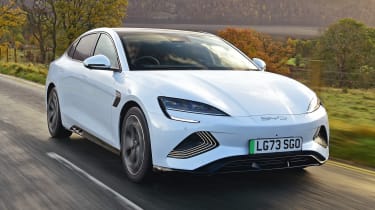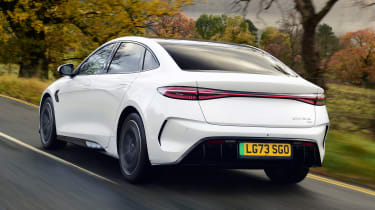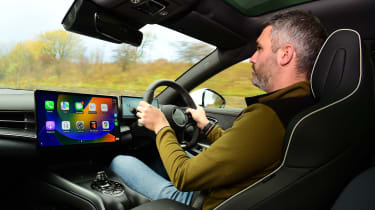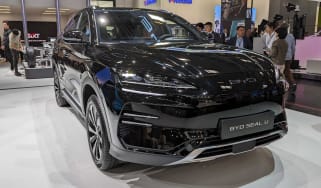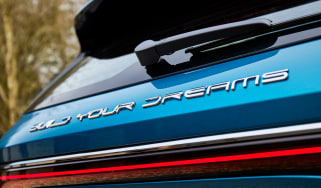New BYD Seal 2023 review: a high quality EV that's great to drive
The all-electric BYD Seal has arrived in the UK to rival the Tesla Model 3 and Hyundai Ioniq 6
Verdict
The BYD Seal feels like a much more mature product than either of the brand’s previous electric cars, and more than lives up to its “next-generation” billing. But with that comes a tangible price premium that puts the sleek saloon on par with (or even slightly above) rivals, rather than allowing it to undercut them as before. Don’t let that dissuade you, however. This is a well-equipped, high-quality, admirably efficient and good-to-drive EV that stacks up well both on paper and in the real world. Few new makers have the potential to make such a significant impact so quickly: BYD is one to watch.
When manufacturers talk of next-generation EVs, you think of industry titans launching a brand-new version of a popular nameplate, or companies implementing substantial tweaks to the batteries or electric motors for big-selling electric SUVs.
You might, therefore, be within your rights to dismiss BYD’s claims that this Seal saloon is a “next-generation” EV – given the fact the maker launched its first car here less than 12 months ago. Hyperbole aside, we’re now driving the Tesla Model 3 rival on British roads, as the Chinese brand continues its assault on the UK market at pace.
Truth be told, the Seal is actually a little longer than the Tesla, both in terms of its wheelbase and outright length. This, added to the super-thin Blade Battery, means the BYD feels like a much bigger car inside. Indeed, there’s enough room for even taller adults to sit comfortably in the back, and puts the sleeker Hyundai Ioniq 6 to shame.
The Seal gets a similarly narrow boot opening, however. The 400-litre capacity is some way off the best in this class, and a BMW i4’s hatchback is much more practical in daily use. The BYD does at least get some underfloor storage, and there’s a useful 53-litre frunk for keeping the charge cables.
Underpinning the BYD Seal is the same e-Platform 3.0 used on the existing Atto 3 SUV and Dolphin supermini, upscaled for the saloon’s extra length. It’s the first of BYD’s Brit-bound models to make the switch from front to rear-wheel drive, though the version we tried was the top-spec Excellence with an additional motor on the front axle.
That “next-generation” billing is evident from the moment you move off. The car feels immediately more focused, even at low speeds. There’s a slight chatter from the ride, which is firmer here than BYD’s previous efforts. But compliant damping takes the edge off any harsh jolts. The steering is measurably weightier too, which along with the lower driving position, unquestionably positions the Seal as the brand’s most driver-oriented car to date.
It’s quick, too. We’ve not yet tried the 309bhp rear-wheel-drive car in the UK, but the range flagship (which costs just £3,000 more) grips and goes brilliantly – even in some of the worst weather the north of England could throw at us. Acceleration isn’t as snappy as a Model 3’s, but we recorded a 3.7-second 0-62mph sprint on a closed track, beating BYD’s own numbers by a tenth of a second.

That slightly firm ride results in decent body control, making the Seal easily as entertaining as a Tesla on the right road. It’s not as fun as an i4, but then, that car sets the driving benchmark in this class. We didn’t think the BYD was as quiet either, though the aforementioned adverse weather likely didn’t do the car any favours in this regard.
The Seal has shown itself in a pretty good light thus far, then – competitive when it comes to space and practicality, as well as displaying tangible gains in handling versus existing BYDs. All this pitches it closely to direct rivals – but what about range, charging, and price?
Let’s cover those off in order. Base rear-drive cars are the most efficient, and claim a maximum 354 miles from an 82.5kWh battery. The extra front motor adds around 130kg, resulting in a near-nine per cent drop in range (323 miles). We didn’t find this to be wildly ambitious either; even on our wet-and-windy test drive, the predicted range readout showed more than 200 miles at 65 per cent of charge.
That puts in the same ballpark as a Model 3 for efficiency, and should enable longer drives without issue. A peak charge rate of 150kW is slightly down on all its main competitors, but a 30-80 per cent charge in 26 minutes means you’ll not be left waiting for long. Three-phase home charging is possible at up to 11kW if you have the necessary hardware, though most owners will still be able to charge via a 7kW wallbox overnight.
Then there’s the price, which at £45,695, means a significant £5,705 premium over the cheapest Tesla. However, a walk-up of just £3k means the dual-motor BYD undercuts its US rival by over £1,000. And that’s before you add 19-inch wheels, different paint or lighter leather to the Model 3. BYD says if you stump up a 20 per cent deposit, you’ll pay £549 a month (7.9 per cent APR) for the base car over four years, with a 10k-mile per year cap. A Model 3, even with a higher APR, is almost £90/month cheaper.
The difference between the entry Seal Design and flagship Excellence AWD that we drove comes down mostly to the powertrain. That said, there are subtle differences to the spec sheet, with the pricier car boasting adaptive dampers, a head-up display and BYD’s Intelligent Torque Adaption Control (iTAC) system – in effect, a torque-vectoring set-up that aims to reduce slip and increases stability.
All that comes in addition to every Seal’s full-length panoramic roof, quilted leather seats and 12-speaker Dynaudio stereo. The infotainment system is a familiar one and lifted wholesale from the Atto 3; the 15.6-inch rotating display runs the same super-fast processor, and there’s Apple and Android connectivity across the board. It’s a shame you have to exit the system to access the climate controls, but at least the icons are responsive.
Quality is good throughout, the seats feel suitably plush both front and rear, and that standard-fit glass roof floods the cabin with light. The side windows are double-glazed, too, which should help refinement at higher speeds.
| Model: | BYD Seal Excellence AWD |
| Price: | £48,695 |
| Powertrain: | 82.5kWh battery, 2x e-motors |
| Power/torque: | 523bhp/670Nm |
| Transmission: | Single-speed auto, four-wheel drive |
| 0-62mph: | 3.8 seconds |
| Top speed: | 112mph |
| Range: | 323 miles |
| Charging: | 150kW, 30-80% in 26 mins |
| Dimensions (L/W/H): | 4,800/1,875/1,460mm |
| On sale: | Now |

